•Overview of Study Session
Date: Wednesday, October 26, 2022
Place: Online
Organizer: Child Research Net (CRN)
•Presenters
Chieko Kibe (Lecturer, Center for Institutional Research, Educational Development, and Learning Support, Ochanomizu University)
Junko Ogawa (Researcher, Child Research Net)
•Program
- Purpose of the study session (Junko Ogawa)
- Opening greeting (Yoichi Sakakihara, Director of Child Research Net)
- Part I: Overview of "Resilience" (Chieko Kibe)
Q&A - Part II: Report on the CRN International Collaborative Survey among Eight Asian Countries (Junko Ogawa)
Interpretation and Suggestions
Purpose of the Study Session
Ogawa: Child Research Net (CRN), sponsored by the Benesse Educational Research & Development Institute, implemented an international collaborative research project titled "Survey on Children's Daily Life among 8 Asian Countries 2021." This survey was conducted in 2021 through collaboration with researchers from eight Asian countries, aiming at determining how to support the development of children who need to survive in challenging times, such as those experienced during the COVID-19 pandemic. The survey theme was children's well-being and resilience during the pandemic.
The survey results revealed that the development of children's resilience was essential for their well-being during the COVID-19 pandemic. After reporting these results as a press release, we received numerous inquiries regarding details of the concept and mechanism of resilience.
Resilience is a relatively new term in the education sector, and its concept is yet to become widespread. Therefore, we have invited Dr. Chieko Kibe, a lecturer at Ochanomizu University. She will explain the concept of resilience in Part I of this workshop. In Part II, we will show the results of this survey and discuss how to nurture children's resilience.
Opening Greeting: Enhancing and Sharing the Understanding of Resilience
Sakakihara: There are numerous ways to evaluate children's development status. For example, we can measure children's cognitive skills (such as reading and writing) and social-emotional skills (such as emotional control and collaborative ability with others).
The term "resilience" has recently garnered attention in the education sector, in the sense of how to survive unpredictable times such as the COVID-19 pandemic or wartime. Resilience is one of the social and emotional skills, and we have been conducting research surveys on the development of children's resilience. However, the concept of resilience is recognized as being fairly broad, even for researchers, which means it might not be easy to understand for ordinary readers. Therefore, we have invited Dr. Chieko Kibe, who specializes in resilience, to speak to us on this concept and provide us with a common understanding. I have been looking forward to this workshop and hope it will give us valuable insights.
Part I: Resilience Study Session - Nurturing Children's Abundant Well-Being
1. Main LecturePresenter: Chieko Kibe (Lecturer, Center for Institutional Research, Educational Development, and Learning Support, Ochanomizu University)
Children with positive deviation under risk draw attention
The word "resilience" is often heard nowadays. Numerous researchers in Japan and overseas are carrying out research into resilience from various angles. In this resilience workshop, I will explain the concept of resilience under the sub-theme of "Promoting children's well-being."
First, I will introduce the history of resilience studies in the psychological domain. In the 1970s, the word "resilience" drew attention from researchers seeking ways to ward off children's risk factors arising from their family environment, such as having parents with mental disorders, poverty, and family discord. For example, the American psychologist Norman Garmezy studied children of mentally ill parents because of their higher risk of developing mental disorders compared with children whose parents were not mentally ill. Garmezy revealed that a certain number of children showed an unexpected positive deviation from such a trend (Garmezy, 1974). At that time, the word "resilience" was not yet used; instead, "Invulnerable children" was used to describe children who were not easily harmed by risk factors. Since then, researchers have been studying such invulnerable children and adopted comparable expressions such as "Invulnerable," "Stress-resistance," "Competence," and "Vulnerable but Invincible."
The term "Resilience" was first used by American developmental psychologists Emmy Werner and Ruth Smith. They conducted a longitudinal study for more than 30 years, targeting about seven hundred children born in Kauai, Hawaii, in 1955 (Werner & Smith, 1982). These subject children had been exposed to various risk factors, such as mentally ill parents, family discord, and unstable family environment. Of them, two-thirds exhibited maladjusted behavior or antisocial tendencies, but the remaining one-third exhibited sound development and adaptation. Werner and Smith described these children as "Resilient Children" (Figure 1).
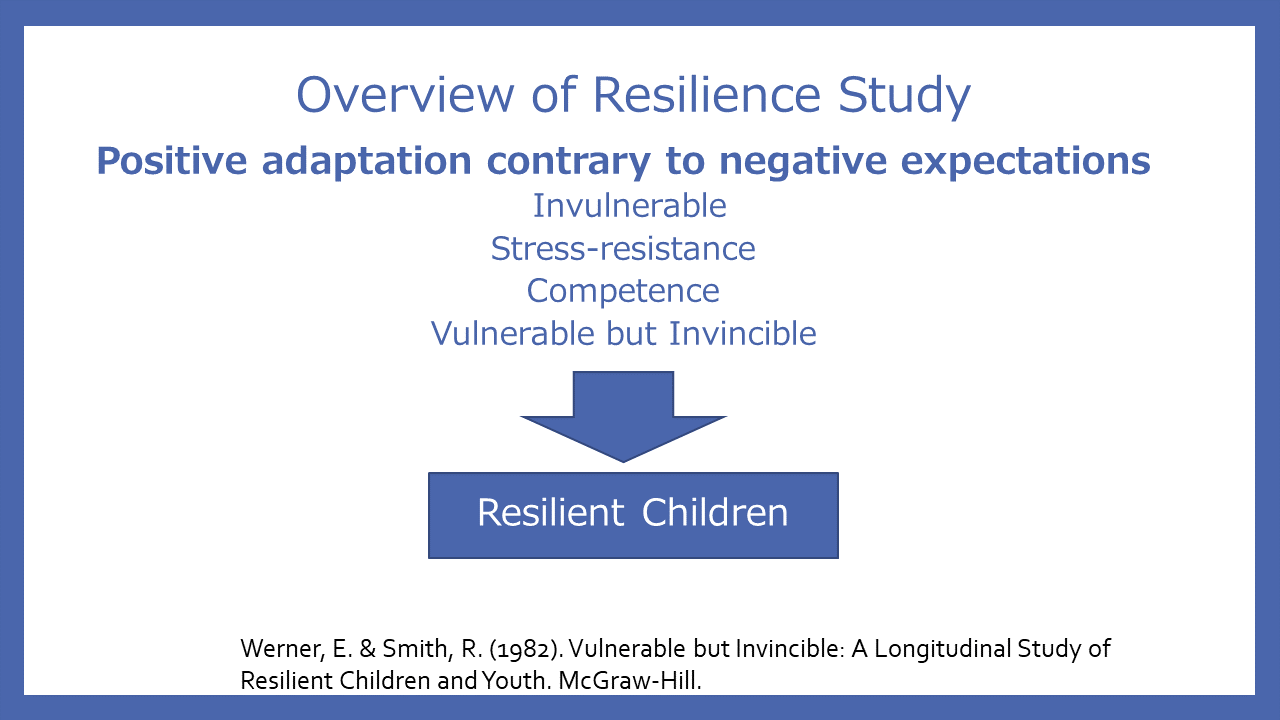
At a later date, the American developmental psychologists Ann S. Masten, Karin M. Best, and Norman Garmezy made the definition that "Resilience refers to the process of, capacity for, or outcome of successful adaptation despite challenging or threatening circumstances" (Masten, Best, & Garmezy, 1990). Since then, resilience has become a prominent research topic among researchers, who typically make a broad definition of the term at the onset of their studies. As a result, the operational definition of resilience can have substantial variation, depending on the various perspectives of individual researchers.
Resilience can be nurtured in the course of ordinary childrearing and educationSince the 1980s, numerous researchers have been conducting studies to ascertain the factors affecting children who develop resilience.
Certain researchers are also conducting studies on how to define risks, because resilience can be recognized only when risks are being faced. The definition of risk can be broad, including hardships and difficulties in ordinary daily life (such as interpersonal conflicts and examination stress) and extra-ordinary daily life (such as natural disasters and pandemics). In addition, studies on resilience indicators that measure the outcome of resilience are showing significant advances. These studies revealed that factors affecting the development of children's resilience can be divided into two aspects; namely the external and internal aspects (Table 1).
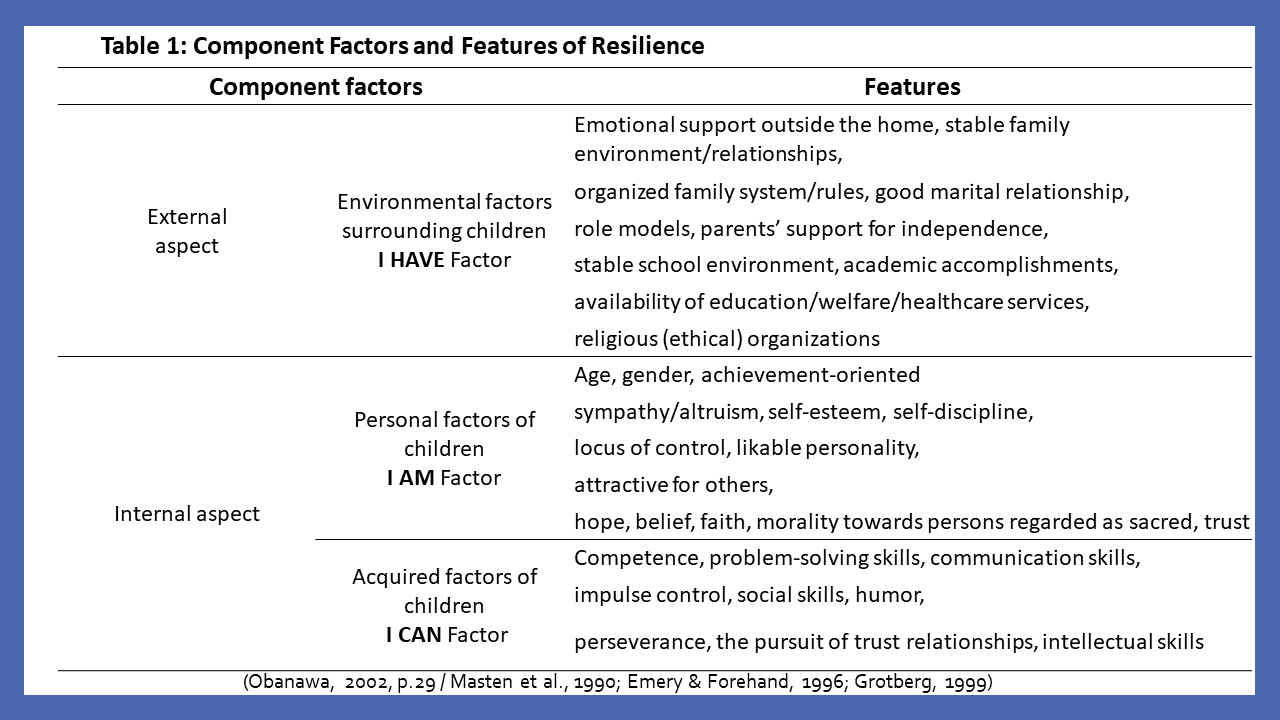
In early studies, resilience was considered to be a "positive deviation," which could only be observed in limited numbers of people, such as those with high IQ. However, in 2001, Ann Masten published "Ordinary Magic" (Masten, 2000). In this article, she argued that resilience can be developed through ordinary child-rearing and education, leading to positive societal adaptation.
Since then, various interventional studies have been conducted on resilience. The most famous example is the one performed by American psychologist Martin Seligman and others (Seligman, 2002; Gillham et al., 2007). They revealed that early intervention employing cognitive behavioral therapy can be effective to prevent mental health problems. Previously, resilience was considered to be the ability, process, or outcome of positive adaptation in times of hardship; Seligman added a new meaning, "skill," to resilience.
The advancement of such interventional studies prompted researchers to develop measurement scales to evaluate the outcome of resilience. Various scales are currently developed according to the target population (Table 2). For example, Table 3 shows the resilience measurement scales for young children.
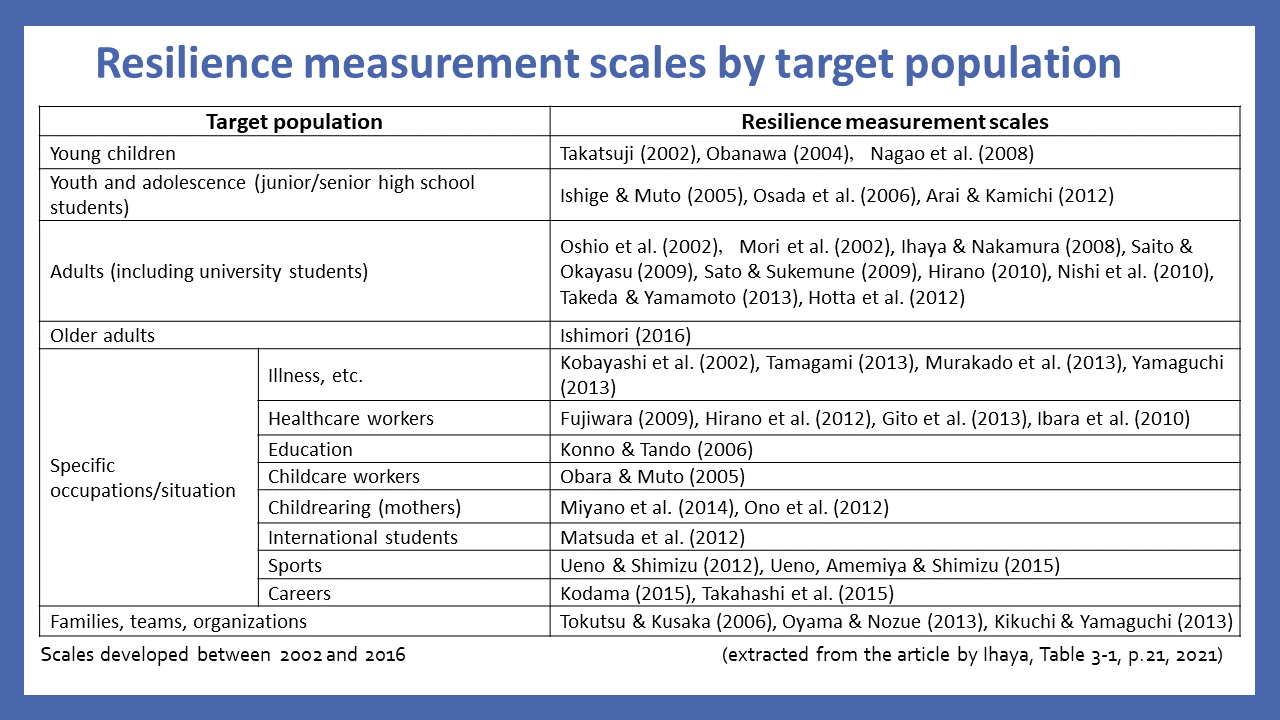
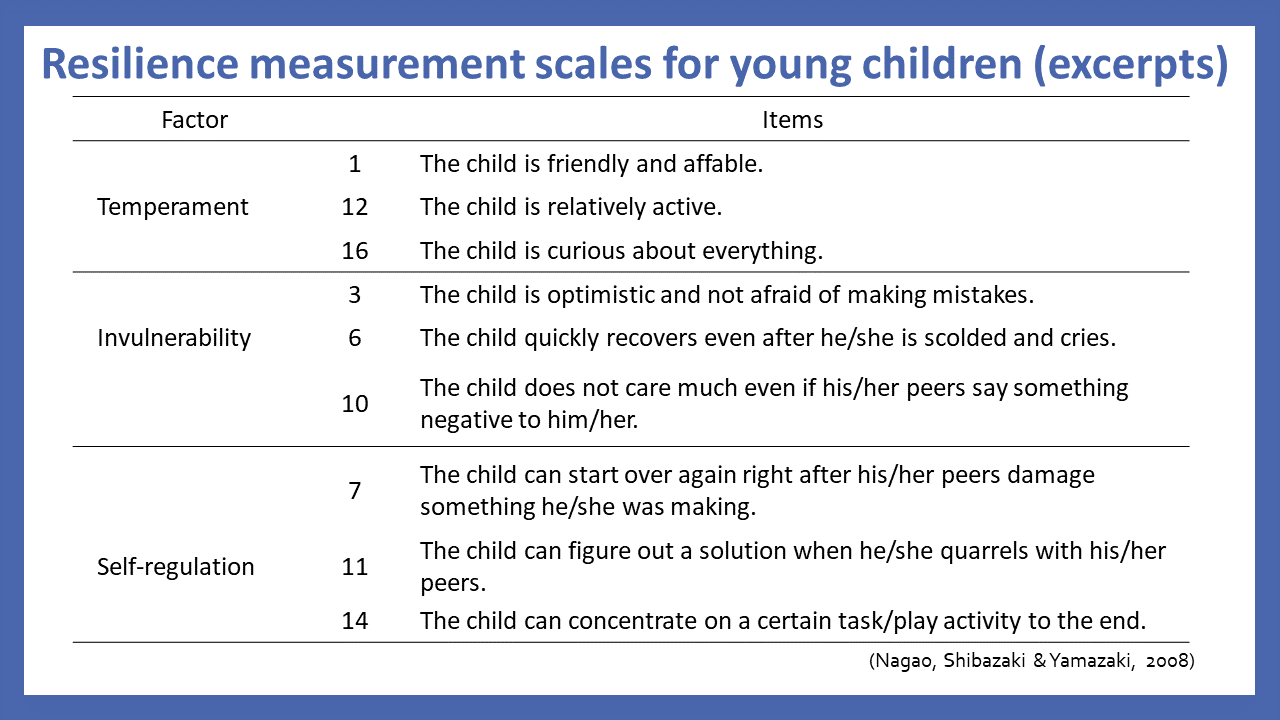
When measuring resilience, the following features should be borne in mind. First, resilience scoring is generally used to measure personal factors contributing to resilience. Therefore, evaluating the status of recovery/adaptation from several angles in parallel, such as the person's well-being, mental health problems, and psychosocial functioning, is desirable. Second, the measurement results should be reviewed as personal progress instead of in comparison with others.
To ensure that the children's developmental environment nurtures their resilience, it is vital to steadily maintain ordinary childrearing practices. Children need nothing special, as Masten pointed out in her paper. Specifically, it is essential to create a "Secure Base" where a child can develop a secure attachment and provide responsive parenting according to each child's temperament and sensitivity. It is also important to ensure social support. A multi-system approach is desirable to support the development of children across society, such as a collaboration between families and kindergarten/school.
In addition, management of risk factors should be considered. Researchers point out that a sound childrearing/educational environment functions as a protective factor that mitigates the impact of risks. It is also essential to provide children with challenging opportunities in safe environment (e.g., at home or kindergarten); children can then try and fail until they work out some solutions (Figure 2).
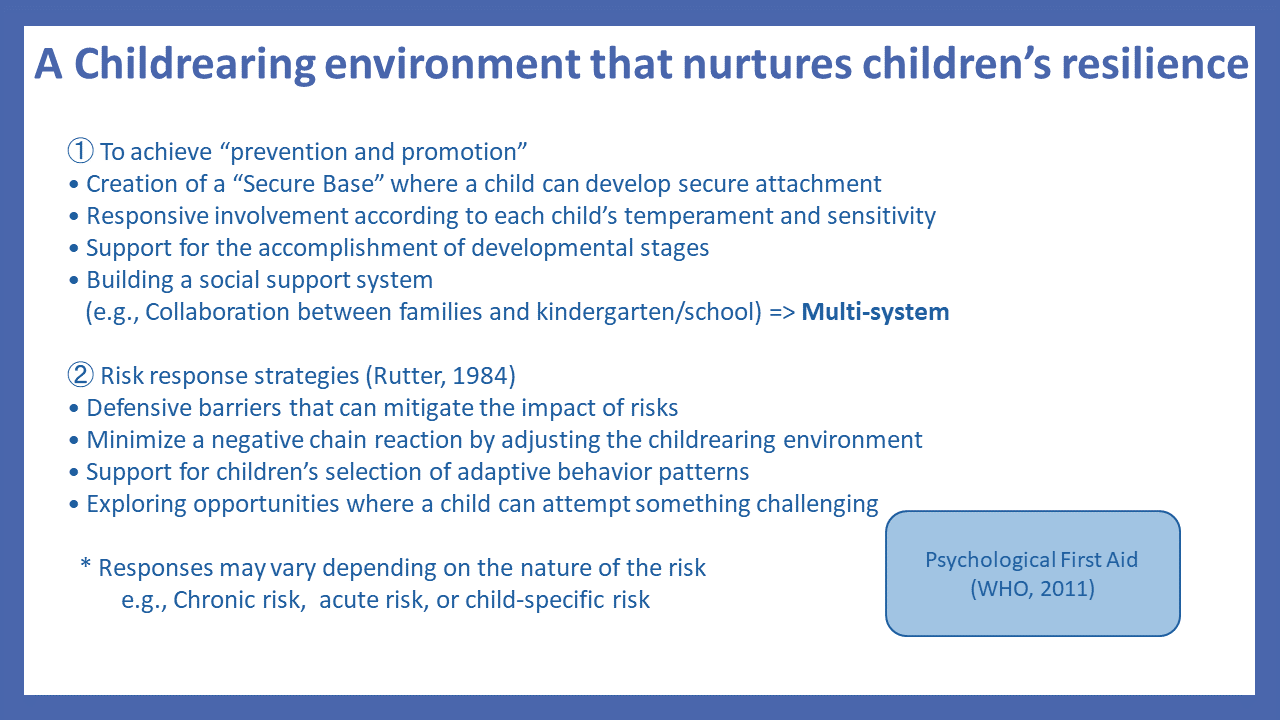
2. Q&A Session
After Dr. Kibe's talk, we conducted a Q&A session. The following questions are part of the discussions.
Question: What kind of children are considered highly resilient?
Kibe: The resilience status varies depending on the child's developmental stage, temperament, personality, etc. So, the focus should be on the progress of each child's personal development instead of comparing it with standard scores or other children. In addition, resilience is considered domain-specific. Therefore, it is likely that a child may be highly resilient in one domain but vulnerable in another domain, experiencing feelings of struggle or difficulties.
Question: What can parents and educators do to nurture children's resilience?
Kibe: I suggest sharing the experience of making mistakes. According to previous studies, repeatedly experiencing minor mistakes in a safe environment is effective in nurturing children's resilience. Unfortunately, in Japan people tend to only think of mistakes in a negative way. Whereas in some schools overseas, they have a "FAIL DAY," on which they all accept each other's mistakes. Posters saying "FAIL=First Attempt In Learning" are put up on the wall, and the culture to accept mistakes from each other is thus assimilated. I hope such a culture can be established in families and schools in Japan.
Part II: Report on the "CRN International Collaborative Survey among Eight Asian Countries"
1. Development of children's resilience based on the results of "Survey on Children's Daily Life among Eight Asian Countries 2021"Presenter: Junko Ogawa (Child Research Net Researcher)
"Parenting Attitude" and "Support from Childcare Facilities" Are Keys for the Development of Children's Resilience
It has become clear that the COVID-19 pandemic has been causing problems to children's mental health and threatening their well-being. Therefore, CRN designed a survey focusing on children's resilience to achieve their well-being in unforeseeable difficult situations such as the COVID-19 pandemic. The purpose of the survey is to explore the environment for nurturing "Happy and Resilient" children during the COVID-19 pandemic from the three environmental perspectives of: families, childcare facilities/schools, and government/society. The method and timing of the survey are as follows: (Figure 1).
The results show that higher well-being was achieved in groups with higher resilience in all eight countries (Figure 2).
In addition, the survey results in Japan show that the mothers' involvement with children is important for developing children's resilience. More specifically, the following three factors were identified as being crucial to development of children's resilience.
①Mothers' responsive parenting attitude, such as talking to the child warmly and gently and having physical contact (Figure 3)②Mothers' childrearing confidence, such as those feeling that their child has grown up fairly well (Figure 4)
③Mothers' support when children are using digital media, such as choosing what the child watches/uses (Figure 5)
Furthermore, the factors of "Support from childcare facilities (caregivers) (Figure 6)" and "Number of friends to play with (Figure 7)" are also effective and influential in developing children's resilience. These factors found to be effective in developing children's resilience in Japan are also effective in other Asian countries (Figure 8).
Therefore, the support of families (parents) hand in hand with childcare facilities (caregivers) is crucial to improve the resilience of children.
2. Dr. Kibe's interpretation and suggestions
Building a multi-system that supports the development of children
After the survey results were reported, Ogawa asked Dr. Kibe some questions:
Ogawa: How do you interpret these survey results?
Kibe: The results of this survey are consistent with the findings of previous resilience studies I just introduced above. This survey confirmed that mothers' responsive interactions could enhance children's emotional stability. In addition, if mothers can obtain effective support from childcare facilities/caregivers, such a situation also contributes to developing children's resilience. I have explained the necessity of building a multi-system based on the findings of previous studies. I believe that the results of this survey corroborate such findings.
Ogawa: Please provide us with your suggestions for future studies based on the findings of this survey.
Kibe: Among the factors found to be effective in developing children's resilience in this survey, I am particularly interested in mothers' support in using digital media. Such support includes choosing what a child watches/uses and determining the length of use/watching. Nowadays, it is much easier to obtain various items of information due to the popularization of ICT. In this regard, parents need to oversee children's usage of digital media instead of letting children be exposed to unlimited information. By providing children with a suitable environment for selected media usage, they can achieve positive development. Therefore, it might be interesting to conduct research into the relationship between parents' digital media usage and their confidence in child-rearing to gain more insightful findings.
https://www.childresearch.net/crna-research-activities.html
References:
- Emery, R. E., & Forehand, R. (1996). Parental divorce and children's well-being: A focus on resilience. In R. J. Haggerty, L. R. Sherrod, N. Garmezy, & M. Rutter (Eds.), Stress, risk, and resilience in children and adolescents: Processes, mechanisms, and interventions (pp. 64-99).
- Cambridge University Press. Garmezy N, Streitman S. (1974). Children at risk: the search for the antecedents of schizophrenia. Part I. Conceptual models and research methods. Schizophr Bull. 1974 Spring;(8):14-90. doi: 10.1093/schbul/1.8.14. PMID: 4619494.
- Grotberg, E. H. (1999) Tapping Your Inner Strength: How to Find the Resilience to Deal With Anything. New age Books.
- Ihaya, K. (2021). Rejiriensu no sokutei [Measuring resilience], chapter 3, Rejiriensu no shinrigaku [Psychology of resilience]. Kaneko Shobo.
- Masten, A.S. (2001). Ordinary Magic. Resilience processes in development. American Psychologist. 2001 Mar;56(3):227-238. doi: 10.1037//0003-066x.56.3.227.
- Masten, A. S., Best, K. M., & Garmezy, N. (1990). Resilience and development: Contributions from the study of children who overcome adversity. Development and Psychopathology, 2(4), 425-444.
https://doi.org/10.1017/S0954579400005812 - Nagao, F., Shibasaki, M., Yamazaki, A. (2008). Making of an Infant resilience scale. The Annural Research on Early Childhood, 2008. Vol.30: 33-39.
- Obanawa, N.W. (2002). Youjiki no shinriteki sutoresu to rejiriensu [Psychological stress and resilience in early childhood]. Physiological Anthropology. Vol. 7 (2002) 1: 29.
- Werner, E. & Smith, R. (1982). Vulnerable but Invincible: A Longitudinal Study of Resilient Children and Youth. McGraw-Hill.
- WHO. (2011) Psychological first aid: Guide for field workers 2.



 Chieko Kibe
Chieko Kibe Junko Ogawa
Junko Ogawa










